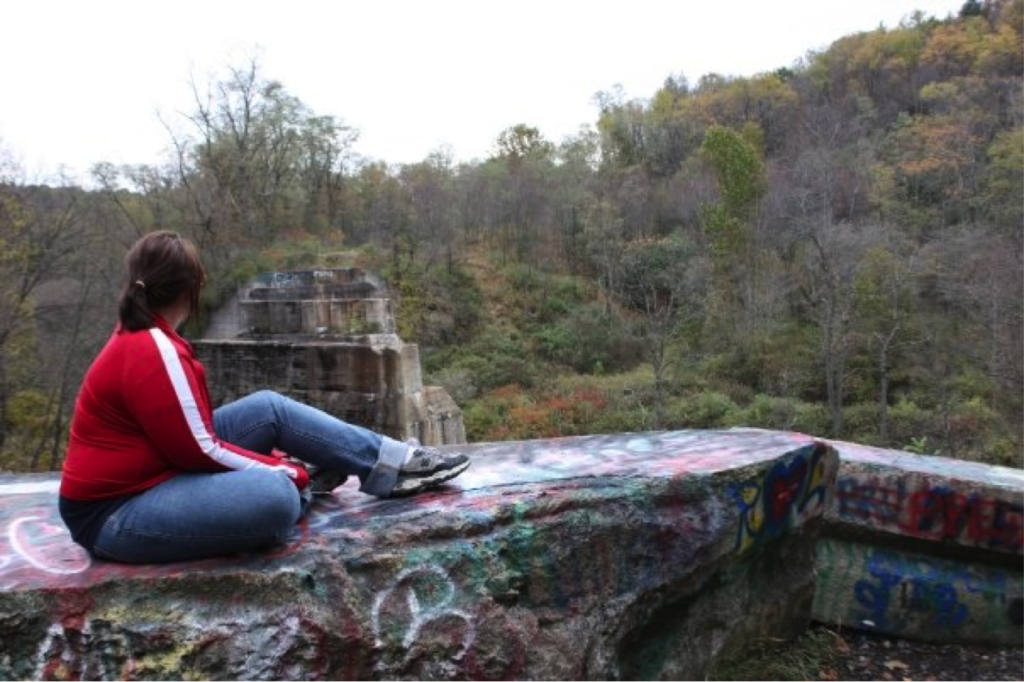by Carly Masiroff
This one moment when you know you’re not a sad story. You are alive. And you stand up and see the lights on the buildings and everything that makes you wonder. – Perks of Being a Wallflower
I have always had an insatiable need to help others. When I saw a problem, I tried everything in my willpower to fix it, even if it ended up with unseen consequences. I needed to make others happy. I never knew why, I just knew I had to do it. To any ordinary person, even my closest friends and family, I seem to be tenaciously facing the world by day, while hiding a dark secret by night. My nights were full of panic attacks and the sheer terror of imagining what “might” happen if I couldn’t help the situation. I would wake up the next morning, exhausted, and get myself ready to take on the day, completely suppressing the night before. I knew the more tenacious I became during the day, the less I felt whatever this terror was at night.
I have been like this most of my life, although it got progressively worse through my adolescence and young adult years. I knew how to fake being normal by watching my friends. But there were times where I lost my ability to suppress, and I experienced moments of extreme exhilaration. I can still picture my best friend’s “simmer down Carly” face. When I saw that look, I knew I wasn’t acting like everyone else. Looking back, I wonder was that mania coming out? Did I learn to “fake” it or “suppress” it so I could resemble being normal? The panic at night thought, I could never suppress. The panic – almost took my life.
I knew I wasn’t normal, and I suppose, subconsciously, I tried to compensate with extreme tenacity. I dove into endless hours of volunteer work while completing my bachelor’s degree. But that wasn’t enough. I went for my master’s degree in a field I knew was the perfect fit. But that wasn’t enough. I made it to my master’s graduation and my grandmother’s funeral in the same day, 150 miles apart. But that wasn’t enough. I struggled but survived through medication changes, friendship changes, and really any kind of change thrown at me. But that wasn’t enough. I was convinced I had conquered this illness, and although it tried to take me down at times, it was not going to take me out.
Then, it did.
One night, my mind convinced itself that my tenacity had driven me so deep that there was only one way out. My mind had convinced itself that I was only a burden on others. My mind had convinced itself that I had reached my peak, helped the people I was supposed to help, and in so much debt and darkness, I could never get out. I gathered all the pill bottles I had, sick of them being a constant presence in my life. Emptied the pills like a coin machine onto my bed and threw the bottles on the floor. Then, one rational thought—call someone. As if by a force of God, I grabbed my phone and called the one person I knew who had been in this situation before. “Please,” I begged her, “tell me this isn’t my only option.” She calmed me down; I hung up the phone exhausted, taking ONLY enough pills to calm me down, and fell asleep. The next morning I woke up as if nothing ever happened.
But something did happen. My panic got to the point of suicidal thoughts that I almost took action on. I had become so driven to be the best I could be, I forgot the most important thing: I could not help anyone until I helped myself. After much convincing from my family and friends, I decided to put my work on hiatus, to focus on myself.
I began a daily outpatient therapy program where I quickly learned that mental illness doesn’t discriminate among age, gender, socioeconomic status, or education level. I would participate in group therapy throughout each day and individual counseling sessions once or twice a week. It was very easy for me, especially in the group therapy sessions, to jump into the counselor role. After all, my counseling classes in graduate school taught me that there’s not always one leader in group sessions, but I chose to take on that role. By helping other people, I could avoid focusing on why I was there. But my depression and anxiety did not stay suppressed for long. I continued having panic attacks and depression so deep, I could not see the light until it was literally shining in my face the next morning. I had become so used to this constant cycle that even when I had succumbed to leaving behind my job and getting help, I still wasn’t phased by the reality that I was having suicidal thoughts.
It was not until about a month later when I saw a phenomenal mentor lose her ten year fight to cancer that the suicidal thoughts really had an impact on me. It was the first time I realized I could have been the one lying in the casket. I was standing in front of the body of a woman who had helped me through panic attacks before I knew what they were. She wrote my recommendation letter to college. This woman with amazing courage and kindness had such hope for me. I had reached a point in my depression where I was defeated enough to want to throw that away. As I left the funeral home, reality hit. I became angry. I was not going to let myself be defeated by this illness. How could I let down the amazing people who had invested so much in me? Loved me? Guided me? I couldn’t throw that away. It was time for a change. Time for me to reclaim my tenacity in a healthy way. Time for me to find the beauty in life again. The next day, I went into group and completely surrendered to the process.


As I was thinking about the theme of this year’s #SACommits series, “This is What Mental Illness Looks Like,” one image came to mind. About six years ago, during my undergraduate experience, a friend took the top photo of me. The one on the bottom is my edited representation of what I saw. Someone once said to me the edited photo reminded them of the Robin Williams movie “What Dreams May Come.” I remember dismissing the notion, as I was terrified of the large imagery in the movie. However, now knowing what I know about myself, it is clear to me that the harsh coloring in the photograph was symbolizing the mania I had experienced throughout my journey. I looked deeper. In the edited version, I was in the shadows. I was in the dark, being taken over by the agitated rainbow around me. The colors were pulsating, distorting my reality.
As I studied the photo further, for the first time, I saw the beauty in the agitated rainbow. The more I learn about my disease and how to combat it, the more I am reminded to step out of the shadows and see the beauty and wonder. This beauty has a purpose—to help me, help others see the beauty in their own distorted reality. I am going to continue to be tenacious, but it has a new meaning for me now. I have officially reclaimed it. Tenacity no longer means becoming better and better, no matter what the cost. I learned the cost, and I wasn’t willing to pay it. Tenacity now means to continue to help myself so I can help others.
I hate telling people my story. To tell you the truth, I avoid it at all costs. I won’t tell my boss, my co-worker or even a close family friend, but I will tell you. It is time I stop acting like my mental health is something to be ashamed of and treat it for what it is, a disease. I am going to start talking. I am going to add my story and activism to the larger scope of ending stigma. Taking one moment at a time, I’m going to try to stop faking it and just—be.
Originally posted at the Student Affairs Collective on May 29, 2015.
